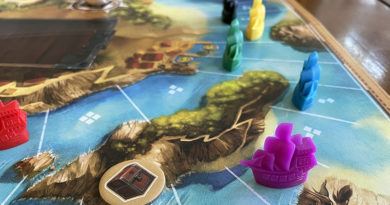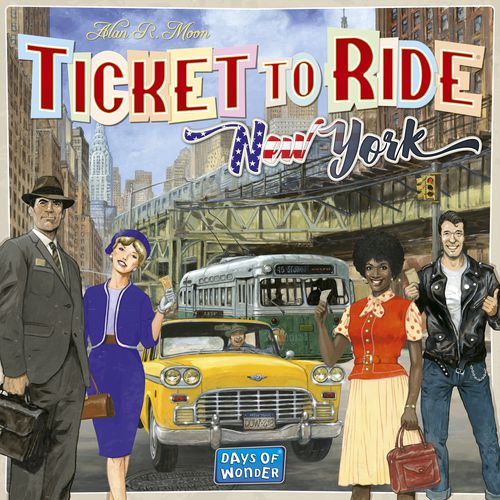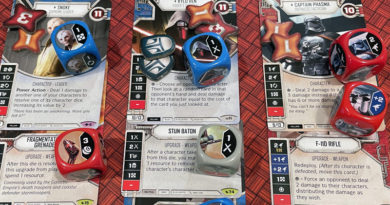The Lord of the Rings: Journeys in Middle-earth board game review
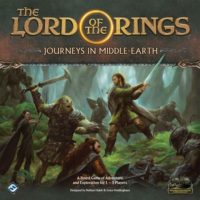
It’s been a while since we’ve reviewed an epic board game.
Well, have we got a doozy for you today!
The Lord of the Rings: Journeys in Middle-earth is a monster of a game from Fantasy Flight Games that we included in the Gamer Games section of last year’s Board Game Gift Guide.
It’s an epic game based on an epic story. But although the characters and themes are based in The Lord of the Rings lore, the adventure is completely new.
Like the Fellowship, the game is a cooperative experience for you and up to 4 of your friends. You’ll battle powerful foes, discover lost treasures, uncover forgotten lore, and customize your skills according to your role within the Fellowship.
Darkness will rise, shadows and corruption will expand and you’ll have to take a stand to survive.
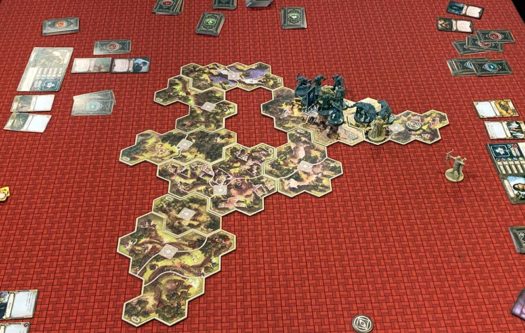
How to play The Lord of the Rings: Journeys in Middle-earth
Because of the epic nature of the game, we’re not going to dive into details of how to play the game. Instead we’ll give a general overview so you can get a sense of how the game plays out.
Each game of The Lord of the Rings: Journeys in Middle-earth is one adventure of a greater campaign. During each adventure, players attempt to complete a number of objectives before being overwhelmed by the threats in Middle-earth.
Whether players finish an adventure successfully or not, they’ll advance to another adventure in the campaign for their next game.
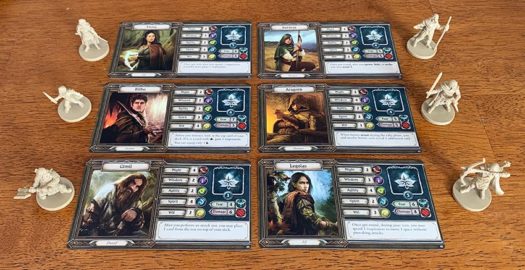
The game is also an app-assisted board game — where the app determines the dangers players will face along the way.
Lest you think the app does everything, note that the game also includes a 16-page Learn to Play booklet as well as a 32-page Rules Reference booklet. And the game box is huge so it can hold the 24 map tiles, 31 plastic figures, hundreds of cards of various types, and lots of tokens and 6 Hero cards.
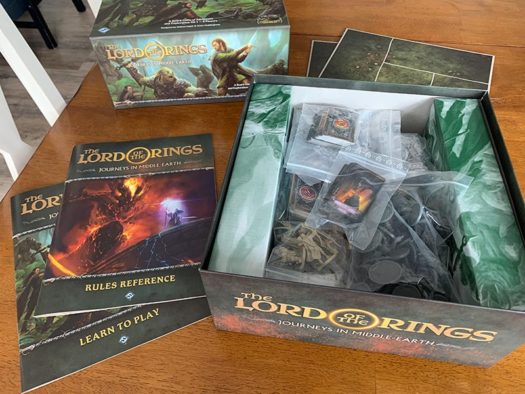
When beginning a new campaign, players will create their campaign difficulty and party of heroes — choosing their roles and gathering their Skill cards (based on the character and chosen role).
Each game adventure session will start with the app presenting the next adventure for the heroes to pursue. Once selected, the app with give instructions on the map tiles to lay out and any tokens to place. Then players are set to begin adventuring.
During each round of a game, players will go through 3 Phases.
Action Phase
Heroes take turns each round in the order of their choice. They’ll use actions to move around the board, attack enemies, and interact with areas of the board. When a player moves into any space on a map tile that has an Exploration token, they collect it and then indicate in the app which tile they’re exploring.
The app will then say what happens next. Usually this involves monsters appearing or new challenges to face. Which also gives reason for there to be an Attack option as an action.
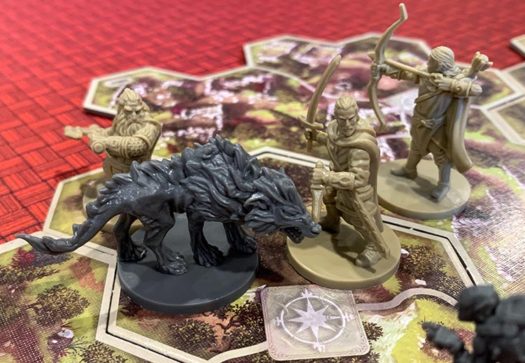
Attacking is done in a unique way in this game.
The player chooses which weapon to attack with which monster group to attack then does an Attack Test. Every “test”, attack included, involves revealing cards from their Skills deck. The player reveals a number of cards equal to their skill level for the trait they’re testing. Or in the case of an attack, matching the icon of the weapon they’re using.
When revealing, the player totals the number of “success” icons shown on the revealed card and compares that with their weapon — which will them tell them the effect.
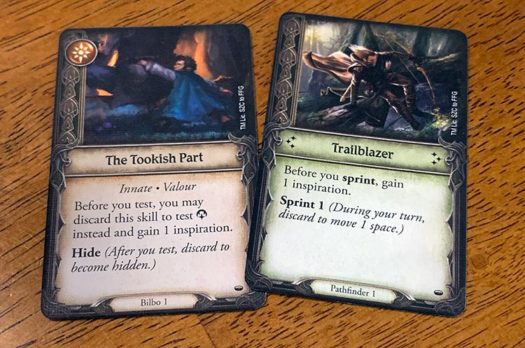
Players enter the results in the app which keeps track of the monster groups and their health (as well as their special abilities).
To use the Interact action, players must be in a location with a token. They select the token in the app and the app will provide instructions to follow.
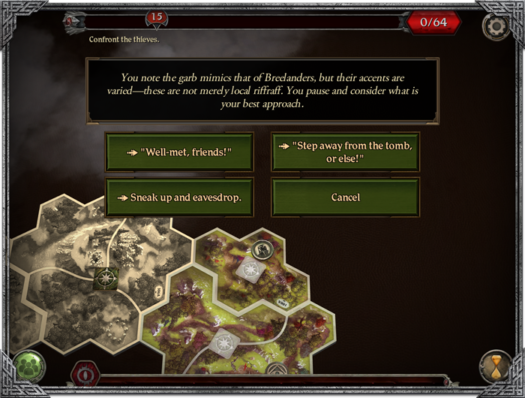
Shadow Phase
During this phase, things happen to hinder the heroes’ progress.
Players indicate on the app once they’ve all taken a turn this round. Then the app guides the players through what happens next in the unfolding adventure.
Enemies activate in groups and will move toward targets (indicated also by the app) and attack.
In addition, there may be Darkness impacting the players and Threats will also increase during this phase. When the Threat level reaches certain thresholds, more things are activated. If the Threat bar fills completely, the heroes fail the adventure.
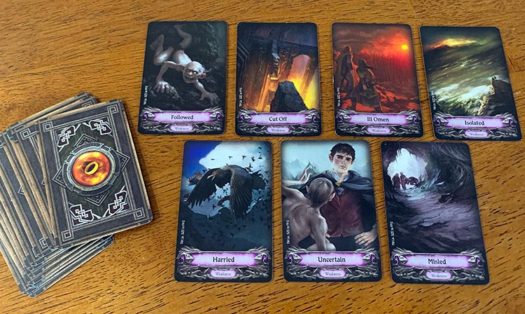
Rally Phase
The Rally Phase is when players prepare for the next round.
Players will Reset their personal Skill decks by shuffling the Skill cards from their deck and discard piles. Then they look at the first 2 cards. The players choose whether to Prepare one them by placing it next to their character card. then they can place the cards not chosen to be Prepared either on the top or bottom of their deck. Thus, they can improve their odds for drawing Successes in their next tests.
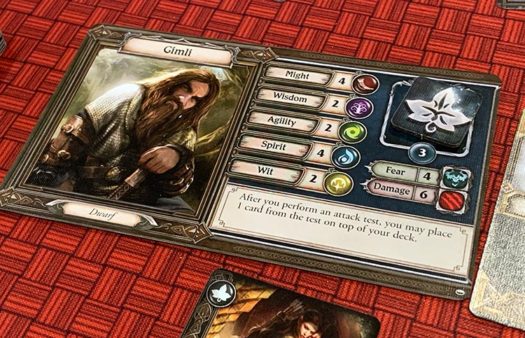
Adventure Complete
If the players complete all their outlined Objectives before the Threat bar is full, they win the adventure!
In either case, win or lose, players will move on to the next adventure for their next game session. If they win, however, they’ll get greater rewards for upgrading their characters and party overall for their upcoming adventures.
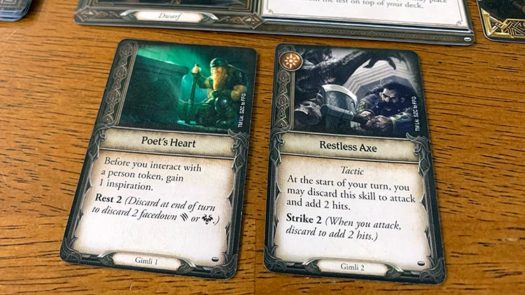
Can the whole family enjoy The Lord of the Rings: Journeys in Middle-earth?
Just the like epic adventure it’s based on, The Lord of the Rings: Journeys in Middle-earth board game isn’t meant to be for everyone.
This is a board game that’s full of theme.
So if you don’t like the theme, you probably won’t like the game.
And if you’ve read this far, my guess is that you pass this first test in that you like (or love) The Lord of the Rings.
In our family, that falls on the boys.
We know a number of ladies that also enjoy The Lord of the Rings so we’re not saying it’s just a “guy-thing”. But they’re not in our family. Mom and Brooke don’t care for the theme around here.
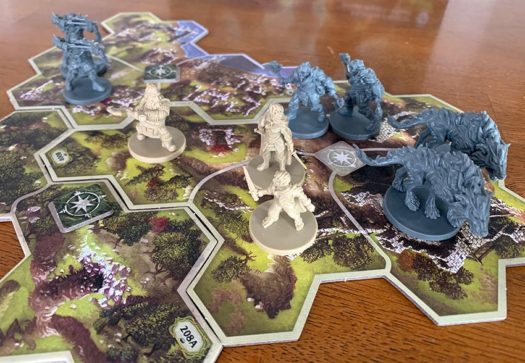
What we enjoy
There are a lot of things we enjoy about The Lord of the Rings: Journeys in Middle-earth.
For starters, we love the variety in the characters with their different skill sets. Even though there are just 6 heroes in the base game, they each have unique Skills cards that fit with their different strengths.
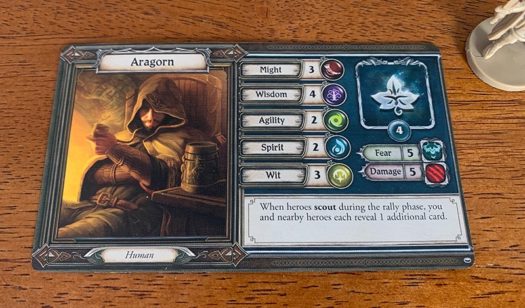
In addition, at the start of every adventure, you can choose to have a different role for your character. So if in one game you chose to be the Burglar, in the next adventure, you can be the Pathfinder or Musician. And each of those roles have their own set of cards that you’ll shuffle into your Skills deck.
Another thing we love is the ability to upgrade our characters between adventures. As we progress through the campaign, our hero characters get more capable to take on the evil lurking in Middle-earth. And it’s fun to feel like we’re getting stronger (even though we know the monsters get tougher along the way too).
We also like the use of Exploration tokens doubling as Success tokens. When you Explore a tile, you collect the token. Later, when you’re doing a test and need a Success, but the cards you reveal just don’t have as many as you need/want, you can spend those Exploration/Success tokens to boost your results.
The hex-type, multi-configuration map tiles are also awesome. Rather than square by square, the odd-shaped map tiles fits in really well to the theme of Middle-earth. It feels much more sprawling than a typical dungeon adventure board and it’s refreshing.
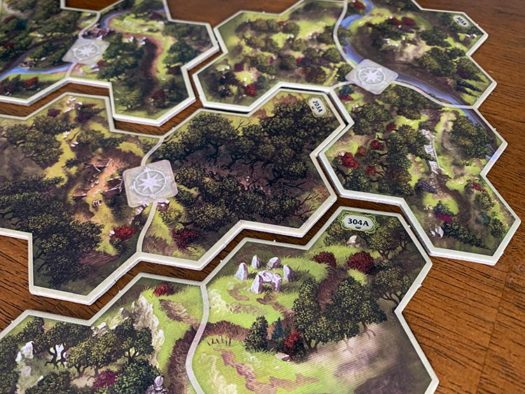
We’re also big fans of the app-assisted board game concept when done right. And Fantasy Flight Games knows how to do it right!
When we first played Descent: Journeys in the Dark (before they had the app-assisted element with that game), we loved diving into campaigns that were broken into individual adventures each time we played. Yet, at the outset of each adventure, the Overlord sets up the whole board, obstacles, and monsters. So the hero players would know at the outset, exactly everything they were going to face along the way.
With the app-assisted element, we now all play on the same team (no one needs to play an Overlord side) and we don’t know what’s coming because the app only unfolds each adventure little by little.
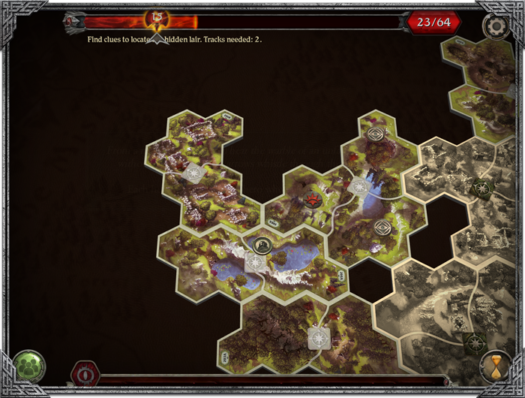
So we’ll typically start an adventure with 3 map tiles out. Then as other things happen through out exploring and battles, more map tiles and enemies appear. So we build the board piece by piece and we face our enemies only as we discover them.
This aspect is what makes it feel like a true adventure — with surprises, setbacks, and all.
Oh, and of course, the miniatures are fantastic!
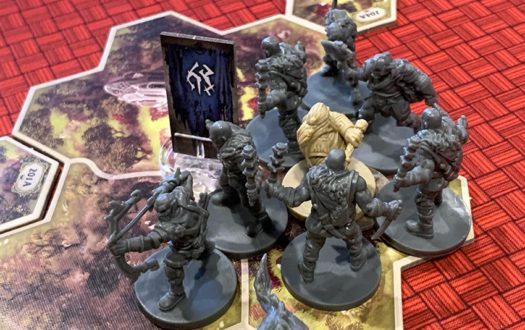
What we don’t enjoy
Remember that novel element we mentioned about revealing Skills cards for successes to Attack enemies and pass the Tests the game presents?
Well, it’s novel and ads some spice to the game. But unfortunately, it also left out a lot of the excitement for us.
Yes, we’re always curious whether we’re going to draw Success or not to pass a test or hurt an enemy, but that anticipation isn’t as exciting for us as rolling dice.
Each card either has a Success icon or not. And the more cards we draw, the better chance we’ll have of getting Successes. But we’ll also see a lot of good cards get passed over — cards that otherwise have a nice ability that we’d like to put into play.
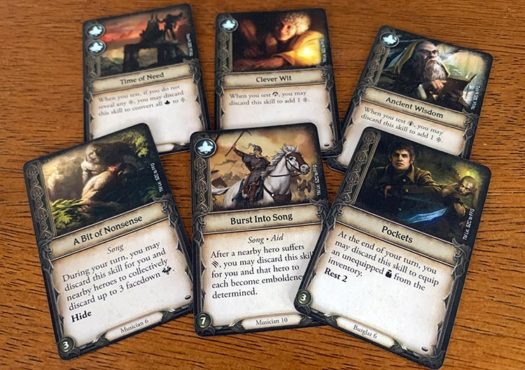
Whereas in Descent: Journeys in the Dark and Star Wars: Imperial Assault (both now app-assisted adventure games as well), tests and combat are resolved with rolling dice. And we find that so much more exciting!
When rolling dice, you’ve got 6 sides on each die with varying icons that may turn up. So we’re always anxiously watching to see how they end up. And we’ve had many awesome, down-to-the wire, stand-up, dice rolls that decide our fate in those games.
But with the card revealing for successes in The Lord of the Rings: Journeys in Middle-earth, we just haven’t had any of those on-the-edge-of-our-seats moments.
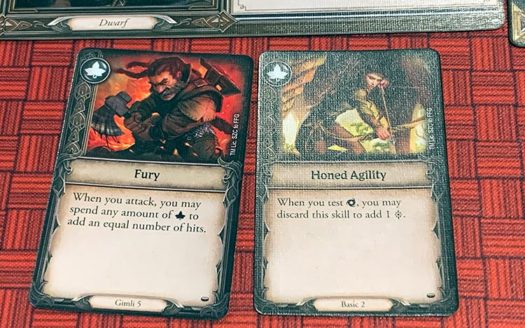
Which also leads to the other thing we don’t enjoy about the game — all the reading.
While we love the app-assisted element on one hand (unfolding the adventure little by little), we haven’t liked that it takes up most of the game play time.
Essentially one person manages the app and reads everything that appears on screen that advances the adventure. The others sit and wait for their turn to take action. But then all their action consists of is moving their hero character up to 2 spaces and flipping over a few cards in their deck to see if they succeed at something. After which, the app-user inputs the results and reads the outcome.
How does The Lord of the Rings: Journeys in Middle-earth score on our “Let’s Play Again” game meter?
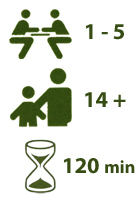 Since the game play is derivative of both Descent: Journeys in the Dark and Star Wars: Imperial Assault, we can’t help but compare the games. And even though those games are also app-assisted campaign games, we feel like we have more choices and options to impact the results in those adventures than we do in LOTR: Journeys in Middle-earth.
Since the game play is derivative of both Descent: Journeys in the Dark and Star Wars: Imperial Assault, we can’t help but compare the games. And even though those games are also app-assisted campaign games, we feel like we have more choices and options to impact the results in those adventures than we do in LOTR: Journeys in Middle-earth.
We go through a lot more team discussions in those games as to what order we should proceed in, where we should move, and what each of us should do. And since so much of the game is in battling and passing tests, we prefer the dice-rolling mechanic more than the card flipping for success. Because dice-rolling usually isn’t an all-or-nothing proposition. Most of the time at least some of the results can be applied for partial impact.
When I ask our boys their preference between these 3 campaign games, they say Descent: Journeys in the Dark hands down. They absolutely love the fantasy and variety packed in Descent. And whereas Lord of the Rings is still fantasy, it’s limited to the lore of that theme vs. the vast fantasy openness of what we find in Descent.
For me, my first choice goes to Star Wars: Imperial Assault because I’m a bigger fan of the Star Wars space-fantasy universe.
Yet that doesn’t mean Journeys in Middle-earth is out the door.
We know we’re still just scratching the surface of what’s packed in The Lord of the Rings: Journeys in Middle-earth. There are many more adventures ahead.
So we’ll keep battling the evils of Middle-earth to come out victorious in the end!
We’d like to thank Fantasy Flight Games for a review copy of The Lord of the Rings: Journeys in Middle-earth.



